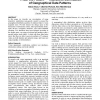Free Online Productivity Tools
i2Speak
i2Symbol
i2OCR
iTex2Img
iWeb2Print
iWeb2Shot
i2Type
iPdf2Split
iPdf2Merge
i2Bopomofo
i2Arabic
i2Style
i2Image
i2PDF
iLatex2Rtf
Sci2ools
CHI
2005
ACM
2005
ACM
"I hear the pattern": interactive sonification of geographical data patterns
In this paper we describe our investigation of using interactive sonification (non-speech sound) to present the geographical distribution pattern of statistical data to vision impaired users. We first discuss the design space in the dimensions of interaction actions, data representation forms, input devices, navigation structures, and sound feedback encoding. Two interfaces have been designed according to the design space, one using a keyboard and another using a smooth surface touch tablet. A study with three blind users shows that they are able to perceive patterns of 5-category values on both familiar and unknown maps, and learn new map geography, in both interfaces. Author Keywords Vision impairment, sonification, auditory user interfaces, information seeking, universal usability ACM Classification Keywords H.5.2.a Auditory (non-speech) feedback; H.5.2.e Evaluation/methodology; H.5.2.q. User ?centered design
CHI 2005 | Human Computer Interaction | Keywords H.5.2.a Auditory | Keywords Vision Impairment | Vision Impaired Users |
| Added | 30 Nov 2009 |
| Updated | 30 Nov 2009 |
| Type | Conference |
| Year | 2005 |
| Where | CHI |
| Authors | Haixia Zhao, Catherine Plaisant, Ben Shneiderman |
Comments (0)

